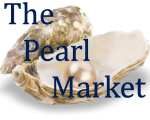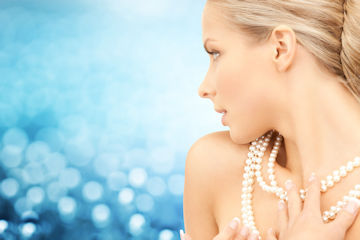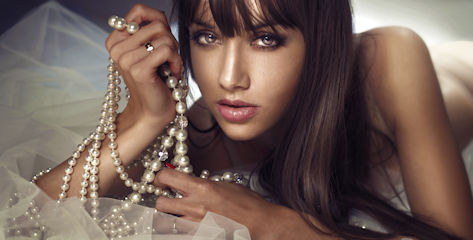A Guide to Pearl Qualities and Grades
Author: The Pearl Market.Buying pearls can be confusing - there are many myths, misconceptions and misleading pieces of information (see buying pearls - tricks and traps). One thing is certain. The romantic image of the pearl fisherman diving off the side of a small boat to harvest pearls from the ocean floor is gone. Perhaps it's just as well. Pearl diving was a dangerous occupation that claimed many lives. Wild pearls still exist but are difficult to find. Nowadays, pearls are cultivated in freshwater lakes and rivers or seawater rafts.
Pearl Grades
Grading takes into account shape, lustre, surface quality, nacre thickness and matching on the strand. There is no international standard for grading pearls so identical pearls may be graded differently by different suppliers.Grading a strand of pearls like a necklace is slightly different to grading individual pearls as not every pearl on the strand will necessarily meet all the criteria.
The pearl industry has it's own jargon but most reputable pearl sellers use the A, AA, AAA grading system, (Tahitian pearls may also use an A to D system) and follow accepted industry conventions.
Tip:
To compare pearl grades like-for-like, a common rule of thumb is to knock off any 'A's after 3 or any '+'signs. For example, AAAA = AAA and AA+ = AA.
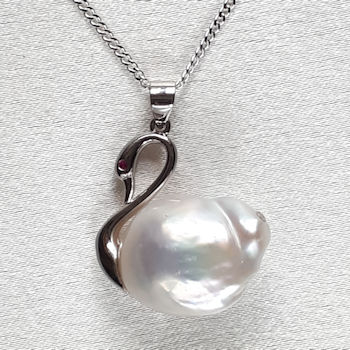 Because of their irregular shape, Baroque Pearls lack any grading convention.
Because of their irregular shape, Baroque Pearls lack any grading convention.Class 1 Baroques, like the one on this elegant swan pendant (See Magical Pendants) describe baroques without unsightly pits, cracks, holes or miscolouration.
| GRADE | A | AA | AAA |
|---|---|---|---|
| Shape | near round | mostly round | round |
| Lustre | fair | good | high |
| Surface | < 75% clean | > 75% clean | > 90% clean |
| Nacre | 0.25 to 0.35mm | 0.35 to 0.5mm | over 0.5mm |
| Matching | fair | good | very good |
Shape
Pearls develop into a variety of shapes. Round pearls are the rarest and the highest priced. The term 'round' does not mean spherical like a marble but the pearls should not look obviously oval or flattened to the naked eye.
It's worth remembering that non-round pearls can offer a lot of pearl for your money. Wild pearls are rarely round so different shapes could be thought more natural.
Lustre
Is the shine that gives pearls their beauty and is an important buying factor. Lustre refers to the pearls brilliance - the way it's surface reflects light, and to it's inner glow - how it refracts light from the layers of nacre within. Pearls with low lustre appear chalky, yellow or dull. Different types of pearl exhibit different types of lustre. For example, bead nucleated pearls with relatively thin nacre may look 'shiny' whereas thick nacre pearls, like South Sea and freshwater pearls, have more of a glow.
Pearls with low lustre appear chalky, yellow or dull. Different types of pearl exhibit different types of lustre. For example, bead nucleated pearls with relatively thin nacre may look 'shiny' whereas thick nacre pearls, like South Sea and freshwater pearls, have more of a glow.Poor lustre pearls are sometimes coated or laquered to improve their appearance but such treatments are only a temporary fix.
Surface Quality
Pearls are a natural product and, like handblown glassware, small natural imperfections are quite acceptable - even desirable. Unacceptable faults include cracks or holes in the surface and thin or flaking nacre.
Grade AAA at least 95% clean
Grade AA at least 75% clean
Grade A less than 75% clean
Pearls which are completely clean - with no scratches, pits, bumps or wrinkles visible to the naked eye - may be designated 'spotless'
Matching
Compares all the pearls on the necklace with each other to see how they match. They don't have to be identical - that can seem artificial and real pearls will vary a little. Most people can judge when something looks wrong, for example, a necklace of 7-8mm pearls where the larger pearls are grouped to one side or a small pearl is sandwiched between two bigger ones. Examine a necklace by placing it on a light cloth background in soft natural daylight. Not indoor lighting, UV displays or direct sunlight. Is the lustre good or are the pearls chalky, yellow or dull? Naturally coloured necklaces can have variations in tone but they shouldn't be glaring.
Examine a necklace by placing it on a light cloth background in soft natural daylight. Not indoor lighting, UV displays or direct sunlight. Is the lustre good or are the pearls chalky, yellow or dull? Naturally coloured necklaces can have variations in tone but they shouldn't be glaring.Turn the necklace in your hands and inspect it from different angles. Use the grading factors above to make a judgement but don't overdo the analysis. If it looks ok it probably is!
Nacre
Seawater pearls are cultivated by implanting an oyster with a mother-of-pearl shell bead. This is called the 'nucleus'.To protect itself, the mollusc coats the bead with layers of nacre. The longer the bead stays in the oyster the more the layers of nacre and the finer the pearl.
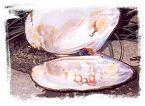
Seawater pearls
Should remain in the ocean for at least two years to develop sufficient layers of nacre.In recent times commercial pressure has resulted in farms harvesting their pearls early, but if a pearl is harvested too soon the thin nacre covering the bead will be prone to cracking and flaking.
Nacre thickness is one reason seemingly identical pearls may be priced differently. On seawater pearls look for a nacre covering of at least 0.3mm, preferably 0.5mm plus.
Freshwater pearls
Use a different culturing technique and take up to six years to grow.
Molluscs are implanted with small pieces of tissue instead of a shell bead. When harvested and drilled the tissue has gone, leaving a solid pearl. Nacre thickness isn't an issue with freshwater pearls.
Edison Pearls
Are a recent innovation in the pearl industry. 'Edison' is a brand name of The Grace Pearl Company (it's like calling a vacuum cleaner a 'Hoover').Edison pearls are big, lustrous pearls cultivated by implanting a shell bead nucleus in a large freshwater mussel. They're less expensive than equivalent South Sea or Tahitian pearls but still not cheap!
Wild Pearls
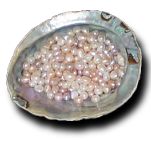
Come in all shapes, colours and sizes. As their name implies, wild or natural pearls are formed without the intervention of man. Overfishing and pollution has eliminated most wild oyster beds but some can still be found in the waters of the Arabian Gulf.
Wild pearls are prized by connoisseurs and a necklace made with natural pearls will be worth many times more than it's cultured pearl equivalent.
In recent years, natural, wild pearl prices have been making headlines in international auction houses. This is due to celebrity endorsement coupled with the realisation that new, good quality, wild pearls, are rare.
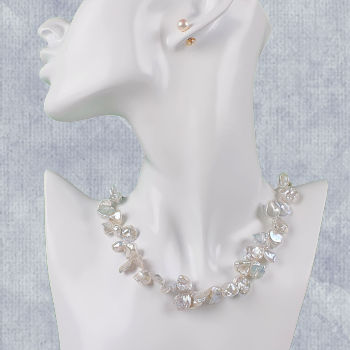 We don't have wild pearls for sale but these Keshi pearls are as close to wild as you're going to get. Keshi pearls form when the mollusc rejects the implanted nucleus and does it's own thing. Purists argue whether Keshi pearls are natural or cultured.
We don't have wild pearls for sale but these Keshi pearls are as close to wild as you're going to get. Keshi pearls form when the mollusc rejects the implanted nucleus and does it's own thing. Purists argue whether Keshi pearls are natural or cultured.Keshi pearls are noted for their flower petal shape and shimmering lustre
See this
